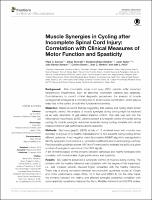Por favor, use este identificador para citar o enlazar este ítem:
https://repositorio.usj.es/handle/123456789/292
| Título : | Muscle synergies in cycling after incomplete spinal cord injury: Correlation with clinical measures of motor function and spasticity |
| Autor: | Oliveira Barroso, Filipe



Torricelli, Diego 


Bravo-Esteban, Elisabeth 

Taylor, Julian Scott 

Gómez-Soriano, Julio 


Santos, Cristina P. 


Moreno, Juan C. 


Pons, José Luis 

|
| Palabras clave : | Sinergias musculares; Lesión de la médula espinal; Ciclismo; Espasticidad |
| Fecha de publicación: | 11-ene-2016 |
| Editorial : | Frontiers Media S. A |
| Citación : | Barroso FO, Torricelli D, Bravo-Esteban E, Taylor J, Gómez-Soriano J, Santos C, Moreno JC and Pons JL (2016) Muscle Synergies in Cycling after Incomplete Spinal Cord Injury: Correlation with Clinical Measures of Motor Function and Spasticity. Front. Hum. Neurosci. 9:706. |
| Descripción : | Background: After incomplete spinal cord injury (iSCI), patients suffer important sensorimotor impairments, such as abnormal locomotion patterns and spasticity. Complementary to current clinical diagnostic procedures, the analysis of muscle synergies has emerged as a promising tool to study muscle coordination, which plays a major role in the control of multi-limb functional movements. Objective: Based on recent findings suggesting that walking and cycling share similar synergistic control, the analysis of muscle synergies during cycling might be explored as an early descriptor of gait-related impaired control. This idea was split into the following two hypotheses: (a) iSCI patients present a synergistic control of muscles during cycling; (b) muscle synergies outcomes extracted during cycling correlate with clinical measurements of gait performance and/or spasticity. Methods: Electromyographic (EMG) activity of 13 unilateral lower limb muscles was recorded in a group of 10 healthy individuals and 10 iSCI subjects during cycling at four different cadences. A non-negative matrix factorization (NNMF) algorithm was applied to identify synergistic components (i.e., activation coefficients and muscle synergy vectors). Reconstruction goodness scores (VAF and r2) were used to evaluate the ability of a given number of synergies to reconstruct the EMG signals. A set of metrics based on the similarity between pathologic and healthy synergies were correlated with clinical scales of gait performance and spasticity. Results: iSCI patients preserved a synergistic control of muscles during cycling. The similarity with the healthy reference was consistent with the degree of the impairment, i.e., less impaired patients showed higher similarities with the healthy reference. There was a strong correlation between reconstruction goodness scores at 42 rpm and motor performance scales (TUG, 10-m test and WISCI II). On the other hand, the similarity between the healthy and affected synergies presented correlation with some spasticity symptoms measured by Penn, Modified Ashworth and SCATS scales. Conclusion: Overall, the results of this study support the hypothesis that the analysis of muscle synergies during cycling can provide detailed quantitative assessment of functional motor impairments and symptoms of spasticity caused by abnormal spatiotemporal muscle co-activation following iSCI. |
| URI : | https://repositorio.usj.es/handle/123456789/292 |
| ISSN : | 16625161 |
| Aparece en las colecciones: | Artículos de revistas |
Ficheros en este ítem:
| Fichero | Descripción | Tamaño | Formato | |
|---|---|---|---|---|
| Muscle synergies in cycling after incomplete spinal cord injury.pdf | 3,1 MB | Adobe PDF |  Visualizar/Abrir |
Este ítem está sujeto a una licencia Creative Commons Licencia Creative Commons

